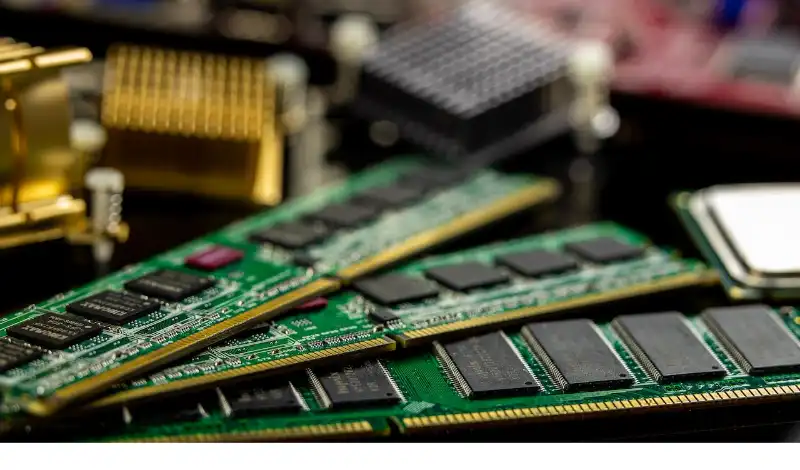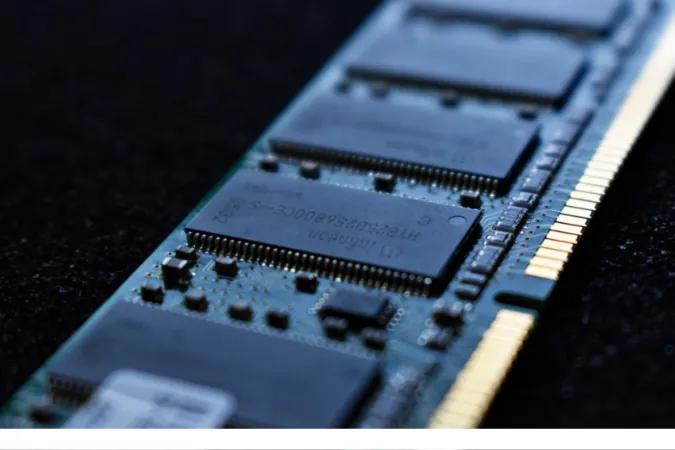Hey there, tech enthusiasts! If you’ve ever wondered, “Is Mac RAM different from PC RAM?” or “Does Mac RAM work in PC?” you’re in the right place.
Today, we’re diving into the fascinating world of RAM, exploring the key differences between PC and Mac RAM. Get ready to become a RAM connoisseur!
Fun Fact #1: Did you know that RAM stands for Random Access Memory? It's a crucial component of every computer, allowing it to store and quickly access data.
What Are The Differences Between a PC RAM and a MAC RAM?
Here are the seven (7) differences;
1: Memory Architectures
When it comes to memory architectures, PCs and Macs have some noteworthy differences. Let’s take a closer look at both:
PC RAM: DDR, DDR2, DDR3, DDR4, and DDR5
PC RAM is based on the widely used Double Data Rate (DDR) architecture. Over the years, this architecture has gone through multiple iterations, including DDR2, DDR3, DDR4, and the latest DDR5.
Each generation offers increased speed, improved performance, and reduced power consumption. You’ll find these RAM modules in a wide range of PCs, from budget-friendly options to high-end gaming rigs.
Mac RAM: Apple’s Custom Solutions
Macs, on the other hand, have historically used the same DDR-based RAM as PCs. However, with the introduction of Apple’s custom M1 chip, Mac RAM has taken a unique turn.
In the latest M1-powered Macs, the RAM is integrated directly into the processor, resulting in lightning-fast memory access and improved efficiency. This innovative design makes Mac RAM stand out from its PC counterpart.
So, when someone asks you, “Is Mac RAM better than PC RAM?” you can confidently say that it depends on the specific Mac and PC models in question.
Fun Fact #2: The first RAM modules were invented in 1968 by Robert H. Dennard, an American electrical engineer. Talk about a blast from the past!
2. RAM Speeds
Now that we’ve talked about memory architectures, let’s discuss RAM speeds.
How fast your RAM can operate directly impacts your computer’s overall performance.
PC RAM Speeds
PC RAM speeds vary depending on the DDR generation. As we progress from DDR to DDR5, speeds increase significantly:
- DDR: 200-400 MHz
- DDR2: 400-800 MHz
- DDR3: 800-2133 MHz
- DDR4: 2133-6400 MHz
- DDR5: 4800-8400 MHz (and beyond)
Keep in mind that these speeds are just general ranges, and individual RAM modules may have slightly different performance specs.
Mac RAM Speeds
Mac RAM speeds have historically been in line with those of their PC counterparts. However, with the introduction of the M1 chip, comparing Mac RAM directly to PC RAM speeds is challenging.
Since M1 Macs have RAM integrated into the processor, they achieve ultra-fast memory access and efficient communication between components.
This integration can result in a noticeable performance boost compared to traditional RAM modules.
So, if you’re wondering, “Can you use normal RAM with a Mac?” the answer is yes, but only for older Mac models. The latest M1 Macs use their unique integrated memory solution.
3. Memory Capacity
Memory capacity is another significant difference between PC and Mac RAM. The amount of RAM in your computer can impact multitasking capabilities and the performance of demanding applications.
PC RAM Capacity
PCs offer a wide range of RAM capacities, depending on the system’s intended use. Budget PCs may come with as little as 4 GB of RAM, while high-end gaming and workstation PCs can support 128 GB or even more.
PCs generally provide greater flexibility when it comes to RAM capacity, allowing you to tailor your system to your needs and budget.
Mac RAM Capacity
Mac RAM capacities have typically been more limited compared to PCs. Older Mac models often started at 8 GB, with options to upgrade to 16 GB or 32 GB.
With the introduction of the M1 chip, Mac RAM capacities have shifted. M1 Macs currently offers 8 GB or 16 GB of unified memory.
While this may seem lower than some PCs, the efficient memory architecture of M1 Macs can still deliver impressive performance.
Ultimately, PC RAM tends to offer a broader range of capacities, while Mac RAM focuses on delivering efficiency with more limited options.
4. RAM Upgradeability
Let’s talk about upgrading RAM. The ability to upgrade RAM can be an essential consideration when purchasing a computer, as it allows you to extend the life of your machine and adapt to changing needs.
Upgrading PC RAM
One of the biggest advantages of PCs is their upgradeability. Most PCs, especially desktops, offer user-friendly access to RAM slots, making upgrading or replacing RAM modules relatively easy.
This flexibility allows you to increase your computer’s performance and lifespan without investing in an entirely new system.
Upgrading Mac RAM
Upgrading Mac RAM has been a mixed bag over the years. Some older Mac models, like the Mac Pro and certain iMacs, had user-accessible RAM slots, making upgrades fairly simple.
However, recent MacBook models and the M1 Macs have integrated RAM, meaning it’s not user-upgradable.
If you’re considering a new Mac, choosing the right RAM capacity upfront is crucial, as you won’t be able to upgrade it later.
In summary, PCs generally offer more RAM upgradeability than Macs, giving you the option to enhance your system as needed.
5. Error-Correcting Code (ECC) Memory
ECC memory is a type of RAM that can detect and correct data corruption. While not necessary for all users, it can be essential in professional environments where data integrity is critical.
ECC Memory in PCs
ECC memory is more commonly found in PCs, particularly in workstations and servers. Many PCs offer support for ECC RAM, giving users the option to choose between standard and ECC memory based on their needs.
ECC RAM can provide added stability and reliability, making it a popular choice for professionals who can’t afford data corruption or system crashes.
ECC Memory in Macs
Historically, ECC memory has been less common in Macs. However, some Mac models, like the Mac Pro, do support ECC RAM.
As for the M1 Macs, they don’t currently offer ECC memory support. Apple’s focus with the M1 chip has been on efficiency and performance rather than the specialized functionality that ECC memory provides.
In conclusion, PCs tend to offer more flexibility when it comes to ECC memory options, while Macs have a more limited selection.
6. RAM Compatibility
Understanding RAM compatibility is essential when upgrading or building a custom computer. Compatibility issues can lead to performance problems or even prevent your system from booting.
PC RAM Compatibility
When it comes to PC RAM, compatibility depends on factors like the motherboard, processor, and RAM type (DDR, DDR2, DDR3, etc.).
To ensure compatibility, you’ll need to check your motherboard’s specifications for supported RAM types, speeds, and capacities.
This information is usually available on the manufacturer’s website or in the motherboard manual.
Mac RAM Compatibility
Mac RAM compatibility is generally more straightforward. Apple has historically used standardized RAM types, making it easier to find compatible upgrades.
However, with the introduction of the M1 chip, Mac RAM compatibility has become a non-issue for new models, as the RAM is integrated and cannot be upgraded.
When someone asks, “Can you use normal RAM with a Mac?” the answer depends on the specific Mac model.
You can typically use standard DDR-based RAM for older Macs, while M1 Macs have their unique integrated memory.
In summary, PC RAM compatibility requires more research, while Mac RAM compatibility is more straightforward but increasingly limited with newer models.
7. Pricing
PC RAM Pricing
Last but not least, let’s talk about pricing. The cost of RAM can vary widely, and it’s essential to consider the price-to-performance ratio when making a purchase.
PC RAM pricing can range from affordable to quite expensive, depending on factors like the RAM type, capacity, speed, and brand.
Generally, PC RAM is more budget-friendly, particularly when it comes to older DDR generations. However, high-capacity, high-speed modules can still be pricey.
Mac RAM Pricing
Mac RAM has typically been more expensive than PC RAM, particularly when purchasing directly from Apple. Additionally, with the introduction of the M1 chip, Mac RAM pricing has become even more complex.
Since the RAM is integrated into the processor, you’ll need to choose the right capacity upfront, and the cost of upgrading can be significantly higher than for PC RAM.
So, is Mac RAM better than PC RAM? The answer largely depends on your specific needs, budget, and device.
While Mac RAM can offer impressive performance, particularly in M1 Macs, it also comes at a premium price.
Conclusion
We’ve explored the 7 differences between PC RAM and Mac RAM, covering aspects like memory architectures, speeds, capacity, upgradeability, ECC memory, compatibility, and pricing.
PC and Mac RAM have unique advantages and limitations, and the best choice depends on your individual requirements and preferences.
Whether you’re a die-hard Mac fan or a dedicated PC user, understanding these differences will help you make informed decisions about your next computer purchase or upgrade.









